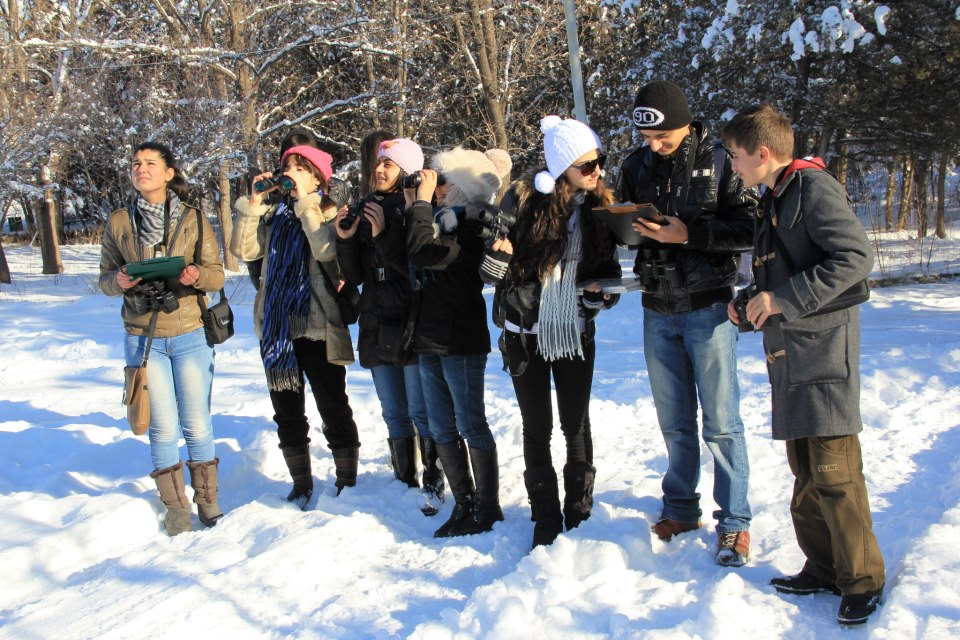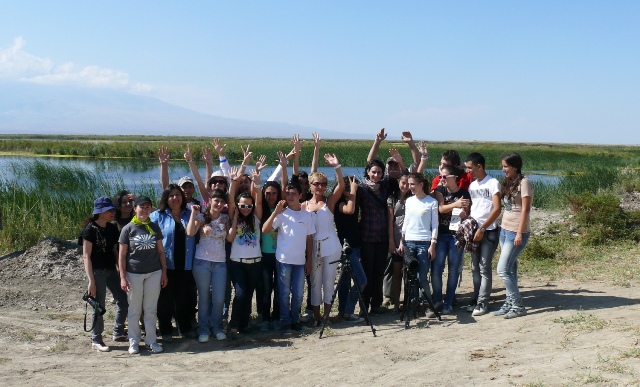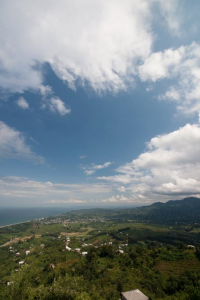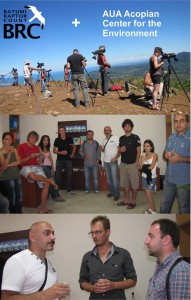Students at Khosrov Reserve, taking coordinates for Bearded Vulture nest.
YEREVAN–For the past year, the AUA Acopian Center for the Environment has been working with students from the “Mkhitar Sebastatsi” Educational Complex in Yerevan, organizing ecological and ornithological clubs for the student to participate in a 10-week ecology and 20-week ornithology courses. Through these clubs, Siranush Tumanyan, the Acopian Center’s Education Outreach Specialist, has worked with almost 50 students (45 high-school and 5 middle-school).
Siranush Tumanyan photographed in the US with an American Turkey Vulture
Taught by Tumanyan, these courses have introduced a new way of teaching these topics. “One of our objectives was to improve the methodology of teaching biology and ecology at schools. I believe we have succeeded. While students participate voluntarily, our retention rates have been very high,” says Tumanyan. “Another sign of success is that other teachers at Mkhitar Sebastatsi are now adopting the same teaching methodology.”
As part of the courses, students go on field trips across the country, visiting key sites such as the Khosrov Preserve, Sevan National Park, Byurakan Forest, Armash Fish Pond, and more.
Each student has a blog where they publish articles they write based on these field trips and classes. “What you see in these blogs are budding scientists and researchers,” says Alen Amirkhanian, Interim Director of the AUA Acopian Center for the Environment. “They are a delight to read. They are informative, insightful, and concise.”
Examples of these student blogs include ones by Avetis Harutunyan, Qristina Atoyan, and Sona Arsenyan.
Ms. Tumanyan has also worked with some students to translate and create e-books on the topics of ecology and ornithology. The first book, an e-book prepared by the 12-year old Erik Sahakyan, is about bird behavior and is intended for younger audiences. Copies of Mr. Sahakyan’s e-book can be viewed and downloaded from here.
A group of 10 students are now preparing a coloring book about wintering birds in Yerevan. Part of the group is working on preparing the text while the others are drawing the illustrations. This, also, is intended for younger audiences.
The AUA Acopian Center is expanding this outreach program to other schools in Yerevan. In the past month, work has started with Ayb High School, with 15 students selected by Ayb to participate in this program. “This expansion fits with our objectives of community outreach,” says Amirkhanian. “We hope that over the coming year we will be able to secure the resources to include 2 more schools.”
For more information, please write to [email protected].

12 participants from high school identify and count birds in the botanical gardens.

15 participants from the high school join with experts from the Zoological institute for international Euro-birdwatching Day in October 2012.
ACE (Acopian Center for the Environment, Tom Lyman & Meike Schaefer)
ECODIT (Environmental Consulting Agency, Kurt Sanderson)
The AUA Acopian Center for the Environment produced the maps for the USAID Armenia Biodiversity Analysis Update Report compiled by ECODIT in December 2008. The following maps were produced and submitted to the Biodiversity Analysis Team Leader:
Duration: 2008-present
Birds of Armenia (Armenia)
Youth in Action Programme (Belgium)
PSOVI (Georgia)
 Raptors are essential part of the wildlife, indicating the health of ecosystem. Change in the Raptors’ number might indicate different type of environmental issues. One of the easiest ways to get imagination of the abundance of different raptor species is to count them on migration since they are getting together on special areas, called “bottleneck sites”.
Raptors are essential part of the wildlife, indicating the health of ecosystem. Change in the Raptors’ number might indicate different type of environmental issues. One of the easiest ways to get imagination of the abundance of different raptor species is to count them on migration since they are getting together on special areas, called “bottleneck sites”.
One of such sites is situated close to Batumi in Western Georgia (Ajaria), on the Black Sea coast, which is close to another raptor counting place – Borchka in Eastern Turkey. Hundreds of thousands of raptors fly through the area during autumn migration (from late August to October).
In 2008 the activity involved 28 volunteers and student trainees from Belgium, Holland, Georgia and Armenia.
 In 2009 other countries have joined the initiative, such as Turkey, France, Sweden, Holland, Belgium, Georgia etc. Apart from participation in the count BOA also took part in organizing and implementing the “Young Birdwatchers Exchange Program”, which aims to bring together birdwatchers from a number of countries. In frames of this project BOA has distributed a recruitment announcement in Armenia, interviewed applicants and selected the most appropriate candidates. Before leaving to Batumi the selected applicants were provided with preliminary training in Armenia, both in auditorium and in the field. BOA provides each of the local candidates with a copy of “A Field Guide to Birds of Armenia”, a pair of binoculars and a spotting scope for use throughout the count.
In 2009 other countries have joined the initiative, such as Turkey, France, Sweden, Holland, Belgium, Georgia etc. Apart from participation in the count BOA also took part in organizing and implementing the “Young Birdwatchers Exchange Program”, which aims to bring together birdwatchers from a number of countries. In frames of this project BOA has distributed a recruitment announcement in Armenia, interviewed applicants and selected the most appropriate candidates. Before leaving to Batumi the selected applicants were provided with preliminary training in Armenia, both in auditorium and in the field. BOA provides each of the local candidates with a copy of “A Field Guide to Birds of Armenia”, a pair of binoculars and a spotting scope for use throughout the count.
Upon arrival to Batumi Karen Aghababyan as a leader teacher gives an intensive raptor identification course for the first three days for all the students of “Young Birdwatchers Exchange Program”.
To teach the student BOA using a part of the Bird Identification Training Course (BITC).
Results
During the counting period (by 6-22 /Sep/2008), there were counted 815374 raptors in average more than 67000 per day. We had huge number of Honey Buzzard, Black Kite, Montagu’s Harrier, Booted Eagle, Levant Sparrowhawk, etc., and also Snake Eagle, Osprey, Lesser Spotted and Steppe Eagle, etc.
During the count of 2009 the Crested Honey Buzzard (Pernis ptilorhynchus) was recorded, the second time for Caucasus.
|
|
 To this day AUA Acopian Center for the Environment continues its cooperation with the Batumi Raptor Count (BRC) by developing and delivering environmental education programs to youth from all parts of the Caucasus. In 2013, Hasmik Ter-Voskanyan (in August) and Siranush Tumanyan (in September) led youth groups, including some from Armenia.
To this day AUA Acopian Center for the Environment continues its cooperation with the Batumi Raptor Count (BRC) by developing and delivering environmental education programs to youth from all parts of the Caucasus. In 2013, Hasmik Ter-Voskanyan (in August) and Siranush Tumanyan (in September) led youth groups, including some from Armenia.
In early September, Dr. Karen Aghababyan, AUA Acopian Center chief scientist, attended the International Batumi Bird Festival organized by BRC. During his visit, Dr. Aghababyan discussed opportunities for expanding cooperation between the organizations through development of nature-based tourism as well as strengthening environmental-education and bird-monitoring programs.
“This is a relationship we want to develop further,” says Alen Amirkhanian, director of the AUA Acopian Center. “Batumi provides an unparalleled setting in the Caucasus to educate and conduct research on the environment. Importantly we are able to do this jointly with people from all parts of the Caucasus and Europe. Developing this type of cooperation is essential for addressing environmental protection needs,” says Amirkhanian.
BRC is a vital nature conservation program in the region. It monitors the more than 850,000 birds of prey that migrate through the “Batumi Bottleneck” every fall. It also works to protect the birds from illegal shootings and trappings, practices that continue to this day.
Batumi is a Black Sea coastal city in the Ajara region of the Republic of Georgia.